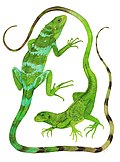Iguana
| Iguana | |
|---|---|

| |
| Green Iguana Iguana iguana | |
| Scientific classification | |
| Kingdom: | |
| Phylum: | |
| Class: | |
| Order: | |
| Suborder: | |
| Family: | |
| Genus: | Iguana Laurenti, 1768
|
| Species | |
| |
Iguana is a genus of lizard native to tropical areas of Central and South America and the Caribbean. The genus was first described in 1768 by Austrian naturalist Josephus Nicolaus Laurenti in his book Specimen Medicum, Exhibens Synopsin Reptilium Emendatam cum Experimentis circa Venena. Two species are included in the genus Iguana: the Green Iguana, which is widespread throughout its range and a popular pet, and the Lesser Antillean Iguana, which is endemic to the Lesser Antilles and endangered due to habitat destruction.
The word "iguana" is derived from a Spanish form of the original Taino name for the species "Iwana".[1]
Anatomy and physiology
The two species of lizard within the genus Iguana possess a dewlap, a row of spines running down their back to their tail, and a third "eye" on their head. This eye is known as the parietal eye, visible as a pale scale on the top of the head. Behind their neck are small scales which resemble spikes, known as tuberculate scales. These scales may be a variety of colors and are not always visible from close distances. They have a large round scale on their cheek known as a subtympanic shield.
Iguanas have excellent vision and can see shapes, shadows, colors and movement at long distances. Iguanas use their eyes to navigate through crowded forests, as well as for finding food. They use visual signals to communicate with other members of the same species.
The tympanum is the iguana's ear drum, and is located above the subtympanic shield and behind the eye. Iguanas are often hard to spot, as they tend to blend into their surroundings. Their scale colors are a mode of hiding from larger predators.
Male iguanas, as well as other male members of the order Squamata, have two hemipenes.
Gallery
-
Green iguana at St. Thomas
-
Another green iguana (Iguana iguana)
-
Green Iguana Iguana iguana from the island of St. Thomas
-
A lesser Antillean iguana in the wild in Dominica.
-
Cayman Iguana
-
Photo taken at La Manzanilla, Jalisco, Mexico at an environmental reserve.
References
- ^ Coles, William (2002), "Green Iguana" (PDF), U.S.V.I. Animal Fact Sheet #08, Department of Planning and Natural Resources US Virgin Islands Division of Fish and Wildlife







